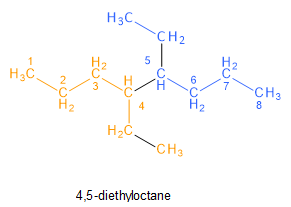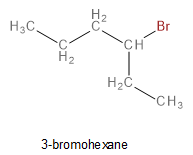
An alkyl bromide (X) reacts with sodium in ether to form 4, 5-diethyl octane, the compound X is:
A. \[C{H_3}{\left( {C{H_2}} \right)_3}Br\]
B. \[C{H_3}{\left( {C{H_2}} \right)_5}Br\]
C. \[C{H_3}{\left( {C{H_2}} \right)_3}CH\left( {Br} \right)C{H_3}\]
D. \[C{H_3} - {\left( {C{H_2}} \right)_2} - CH\left( {Br} \right) - C{H_2} - C{H_3}\]
Answer
222.9k+ views
Hint: All alkyl halides undergo a coupling reaction with sodium in dry ether. The reaction is called the Wurtz Reaction. The product of this reaction is a higher alkane which is made of the alkyl groups of the reactant alkyl halides.
Complete Step by Step Solution:
Alkyl halides (alkyl bromides in this case), in the presence of sodium in dry ether, undergo a reaction called the Wurtz Reaction. This is a coupling reaction between the alkyl halides in which their alkyl groups get attached via a carbon-carbon bond resulting in a higher alkane.
Wurtz reaction can occur between two molecules of the same alkyl halide. In this case, the corresponding higher alkane product will have twice the number of carbon atoms as the reactant alkyl halide. The general scheme is shown below:

Image: General scheme of a Wurtz Reaction between two molecules of the same alkyl bromide
What is of note here, and what will help us solve this question, is that the new carbon-carbon bond of the higher alkane forms between the bromine-carrying carbons of the two alkyl bromides.
The higher alkane given in the question is 4, 5-diethyl octane.

Image: Structure of 4,5-diethyloctane
From the structure, we can observe that 4,5-diethyloctane seems to be made of two identical hydrocarbon fragments (as shown in orange and blue colours), consisting of 6 carbon atoms in a straight chain, attached by a carbon-carbon bond between carbon 4 and carbon 5. Since the new carbon-carbon bond forms between the bromine-carrying carbons, we can deduce that carbons 4 and 5 are the bromine-carrying carbons of the reactant alkyl bromide.
Thus, the structure of the reactant alkyl bromide (X) is

Image: Structure of X
Thus, option D is correct.
Note: To solve questions of this type, it is important to remember that the new carbon-carbon bond of the higher alkane will form between the halide-carrying carbons of the two alkyl halides. Drawing the structure of the given higher alkane will help us identify the alkyl fragments that were coupled in the Wurtz reaction.
Complete Step by Step Solution:
Alkyl halides (alkyl bromides in this case), in the presence of sodium in dry ether, undergo a reaction called the Wurtz Reaction. This is a coupling reaction between the alkyl halides in which their alkyl groups get attached via a carbon-carbon bond resulting in a higher alkane.
Wurtz reaction can occur between two molecules of the same alkyl halide. In this case, the corresponding higher alkane product will have twice the number of carbon atoms as the reactant alkyl halide. The general scheme is shown below:

Image: General scheme of a Wurtz Reaction between two molecules of the same alkyl bromide
What is of note here, and what will help us solve this question, is that the new carbon-carbon bond of the higher alkane forms between the bromine-carrying carbons of the two alkyl bromides.
The higher alkane given in the question is 4, 5-diethyl octane.

Image: Structure of 4,5-diethyloctane
From the structure, we can observe that 4,5-diethyloctane seems to be made of two identical hydrocarbon fragments (as shown in orange and blue colours), consisting of 6 carbon atoms in a straight chain, attached by a carbon-carbon bond between carbon 4 and carbon 5. Since the new carbon-carbon bond forms between the bromine-carrying carbons, we can deduce that carbons 4 and 5 are the bromine-carrying carbons of the reactant alkyl bromide.
Thus, the structure of the reactant alkyl bromide (X) is

Image: Structure of X
Thus, option D is correct.
Note: To solve questions of this type, it is important to remember that the new carbon-carbon bond of the higher alkane will form between the halide-carrying carbons of the two alkyl halides. Drawing the structure of the given higher alkane will help us identify the alkyl fragments that were coupled in the Wurtz reaction.
Recently Updated Pages
JEE General Topics in Chemistry Important Concepts and Tips

JEE Extractive Metallurgy Important Concepts and Tips for Exam Preparation

JEE Atomic Structure and Chemical Bonding important Concepts and Tips

JEE Amino Acids and Peptides Important Concepts and Tips for Exam Preparation

Electricity and Magnetism Explained: Key Concepts & Applications

JEE Energetics Important Concepts and Tips for Exam Preparation

Trending doubts
JEE Main 2026: Application Form Open, Exam Dates, Syllabus, Eligibility & Question Papers

Derivation of Equation of Trajectory Explained for Students

Hybridisation in Chemistry – Concept, Types & Applications

Understanding the Angle of Deviation in a Prism

How to Convert a Galvanometer into an Ammeter or Voltmeter

Degree of Dissociation: Meaning, Formula, Calculation & Uses

Other Pages
Solutions Class 12 Chemistry Chapter 1 CBSE Notes - 2025-26

NCERT Solutions For Class 12 Chemistry Chapter 1 Solutions - 2025-26

The D and F Block Elements Class 12 Chemistry Chapter 4 CBSE Notes - 2025-26

NCERT Solutions for Class 12 Chemistry Chapter Chapter 7 Alcohol Phenol and Ether

NCERT Solutions ForClass 12 Chemistry Chapter Chapter 8 Aldehydes Ketones And Carboxylic Acids

JEE Advanced Marks vs Ranks 2025: Understanding Category-wise Qualifying Marks and Previous Year Cut-offs




